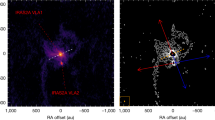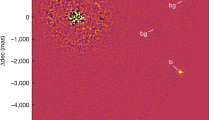Abstract
Many extrasolar planets follow orbits that differ from the nearly coplanar and circular orbits found in our Solar System; their orbits may be eccentric1 or inclined with respect to the host star’s equator2,3, and the population of giant planets orbiting close to their host stars suggests appreciable orbital migration4. There is at present no consensus on what produces such orbits. Theoretical explanations often invoke interactions with a binary companion star in an orbit that is inclined relative to the planet’s orbital plane4,5. Such mechanisms require significant mutual inclinations between the planetary and binary star orbital planes. The protoplanetary disks in a few young binaries are misaligned6,7,8,9,10,11,12, but often the measurements of these misalignments are sensitive only to a small portion of the inner disk, and the three-dimensional misalignment of the bulk of the planet-forming disk mass has hitherto not been determined. Here we report that the protoplanetary disks in the young binary system HK Tauri are misaligned by 60 to 68 degrees, such that one or both of the disks are significantly inclined to the binary orbital plane. Our results demonstrate that the necessary conditions exist for misalignment-driven mechanisms to modify planetary orbits, and that these conditions are present at the time of planet formation, apparently because of the binary formation process.
This is a preview of subscription content, access via your institution
Access options
Subscribe to this journal
Receive 51 print issues and online access
$199.00 per year
only $3.90 per issue
Buy this article
- Purchase on Springer Link
- Instant access to full article PDF
Prices may be subject to local taxes which are calculated during checkout



Similar content being viewed by others
References
Wu, Y. & Murray, N. Planet migration and binary companions: the case of HD 80606b. Astrophys. J. 589, 605–614 (2003)
Winn, J. N., Fabrycky, D., Albrecht, S. & Johnson, J. A. Hot stars with hot Jupiters have high obliquities. Astrophys. J. 718, L145–L149 (2010)
Albrecht, S. et al. Obliquities of hot Jupiter host stars: evidence for tidal interactions and primordial misalignments. Astrophys. J. 757, 18 (2012)
Fabrycky, D. & Tremaine, S. Shrinking binary and planetary orbits by Kozai cycles with tidal friction. Astrophys. J. 669, 1298–1315 (2007)
Batygin, K. A primordial origin for misalignments between stellar spin axes and planetary orbits. Nature 491, 418–420 (2012)
Stapelfeldt, K. R. et al. An edge-on circumstellar disk in the young binary system HK Tauri. Astrophys. J. 502, L65–L69 (1998)
Koresko, C. D. A circumstellar disk in a pre–main-sequence binary star. Astrophys. J. 507, L145–L148 (1998)
Roccatagliata, V. et al. Multi-wavelength observations of the young binary system Haro 6-10: the case of misaligned discs. Astron. Astrophys. 534, A33 (2011)
Bohm, K. H. & Solf, J. A sub-arcsecond-scale spectroscopic study of the complex mass outflows in the vicinity of T Tauri. Astrophys. J. 430, 277–290 (1994)
Duchêne, G., Ghez, A. M., McCabe, C. & Ceccarelli, C. The circumstellar environment of T Tauri S at high spatial and spectral resolution. Astrophys. J. 628, 832–846 (2005)
Skemer, A. J. et al. Evidence for misaligned disks in the T Tauri triple system: 10 μm superresolution with MMTAO and Markov chains. Astrophys. J. 676, 1082–1087 (2008)
Ratzka, T. et al. Spatially resolved mid-infrared observations of the triple system T Tauri. Astron. Astrophys. 502, 623–646 (2009)
Monin, J. L., Menard, F. & Duchêne, G. Using polarimetry to check rotation alignment in PMS binary stars. Principles of the method and first results. Astron. Astrophys. 339, 113–122 (1998)
Jensen, E. L. N., Mathieu, R. D., Donar, A. X. & Dullighan, A. Testing protoplanetary disk alignment in young binaries. Astrophys. J. 600, 789–803 (2004)
Moneti, A. & Zinnecker, H. Infrared imaging photometry of binary T Tauri stars. Astron. Astrophys. 242, 428–432 (1991)
Torres, R. M., Loinard, L., Mioduszewski, A. J. & Rodríguez, L. F. VLBA determination of the distance to nearby star-forming regions. III. HP Tau/G2 and the three-dimensional structure of Taurus. Astrophys. J. 698, 242–249 (2009)
Andrews, S. M., Rosenfeld, K. A., Kraus, A. L. & Wilner, D. J. The mass dependence between protoplanetary disks and their stellar hosts. Astrophys. J. 771, 129 (2013)
McCabe, C. et al. Spatially resolving the HK Tau B edge-on disk from 1.2 to 4.7 μm: a unique scattered light disk. Astrophys. J. 727, 90 (2011)
Jensen, E. L. N. & Akeson, R. L. Protoplanetary disk mass distribution in young binaries. Astrophys. J. 584, 875–881 (2003)
Duchêne, G., Menard, F., Stapelfeldt, K. & Duvert, G. A layered edge-on circumstellar disk around HK Tau B. Astron. Astrophys. 400, 559–565 (2003)
Kozai, Y. Secular perturbations of asteroids with high inclination and eccentricity. Astron. J. 67, 591–598 (1962)
Lidov, M. L. The evolution of orbits of artificial satellites of planets under the action of gravitational perturbations of external bodies. Planet. Space Sci. 9, 719–759 (1962)
Innanen, K. A., Zheng, J. Q., Mikkola, S. & Valtonen, M. J. The Kozai mechanism and the stability of planetary orbits in binary star systems. Astron. J. 113, 1915–1919 (1997)
Naoz, S., Farr, W. M., Lithwick, Y., Rasio, F. A. & Teyssandier, J. Secular dynamics in hierarchical three-body systems. Mon. Not. R. Astron. Soc. 431, 2155–2171 (2013)
Bate, M. R. et al. Observational implications of precessing protostellar discs and jets. Mon. Not. R. Astron. Soc. 317, 773–781 (2000)
Bate, M. R. Stellar, brown dwarf and multiple star properties from a radiation hydrodynamical simulation of star cluster formation. Mon. Not. R. Astron. Soc. 419, 3115–3146 (2012)
Offner, S. S. R., Klein, R. I., McKee, C. F. & Krumholz, M. R. The effects of radiative transfer on low-mass star formation. Astrophys. J. 703, 131–149 (2009)
Fragner, M. M. & Nelson, R. P. Evolution of warped and twisted accretion discs in close binary systems. Astron. Astrophys. 511, A77 (2010)
Clarke, C. J. in Proc. IAU Symp. S240 Vol. 2 (eds Hartkopf, W. I., Guinan, E. F. & Harmanec, P. ) 337–346 (International Astronomical Union, 2007)
Offner, S. S. R., Kratter, K. M., Matzner, C. D., Krumholz, M. R. & Klein, R. I. The formation of low-mass binary star systems via turbulent fragmentation. Astrophys. J. 725, 1485–1494 (2010)
Akeson, R. L. & Jensen, E. L. N. Circumstellar disks around binary stars in Taurus. Astrophys. J. 784, 62 (2014)
Guilloteau, S. et al. A sensitive survey for 13CO, CN, H2CO, and SO in the disks of T Tauri and Herbig Ae stars. Astron. Astrophys. 549, A92 (2013)
Hartmann, L., Calvet, N., Gullbring, E. & D'Alessio, P. Accretion and the evolution of T Tauri disks. Astrophys. J. 495, 385–400 (1998)
Rosenfeld, K. A., Andrews, S. M., Wilner, D. J., Kastner, J. H. & McClure, M. K. The structure of the evolved circumbinary disk around V4046 Sgr. Astrophys. J. 775, 136 (2013)
Papaloizou, J. C. B. & Terquem, C. On the dynamics of tilted discs around young stars. Mon. Not. R. Astron. Soc. 274, 987–1001 (1995)
Larwood, J. D., Nelson, R. P., Papaloizou, J. C. B. & Terquem, C. The tidally induced warping, precession and truncation of accretion discs in binary systems: three-dimensional simulations. Mon. Not. R. Astron. Soc. 282, 597–613 (1996)
Lubow, S. H. & Ogilvie, G. I. On the tilting of protostellar disks by resonant tidal effects. Astrophys. J. 538, 326–340 (2000)
Dullemond, C. P. RADMC-3D: A multi-purpose radiative transfer tool. Astrophysics Source Code Library 1202. 015, http://asterisk.apod.com/viewtopic.php?f = 35&t = 27484 (2012)
Foreman-Mackey, D., Hogg, D. W., Lang, D. & Goodman, J. emcee: the MCMC hammer. Publ. Astron. Soc. Pacif. 125, 306–312 (2013)
Goodman, J. & Weare, J. Ensemble samplers with affine invariance. Commun. Appl. Math. Comput. Sci. 5, 65–80 (2010)
Heintz, W. D. Double Stars 32 (Reidel, 1978)
Piétu, V., Dutrey, A. & Guilloteau, S. Probing the structure of protoplanetary disks: a comparative study of DM Tau, LkCa 15, and MWC 480. Astron. Astrophys. 467, 163–178 (2007)
Bally, J., Walawender, J. & Reipurth, B. Deep imaging surveys of star-forming clouds. V. New Herbig-Haro shocks and giant outflows in Taurus. Astron. J. 144, 143 (2012)
Simon, M., Dutrey, A. & Guilloteau, S. Dynamical masses of T Tauri stars and calibration of pre-main-sequence evolution. Astrophys. J. 545, 1034–1043 (2000)
Rosenfeld, K. A., Andrews, S. M., Wilner, D. J. & Stempels, H. C. A. Disk-based dynamical mass estimate for the young binary V4046 Sgr. Astrophys. J. 759, 119 (2012)
Rosenfeld, K. A., Andrews, S. M., Hughes, A. M., Wilner, D. J. & Qi, C. A spatially resolved vertical temperature gradient in the HD 163296 disk. Astrophys. J. 774, 16 (2013)
de Gregorio-Monsalvo, I. et al. Unveiling the gas-and-dust disk structure in HD 163296 using ALMA observations. Astron. Astrophys. 557, A133 (2013)
Acknowledgements
We thank S. Schnee for help in reducing the ALMA data, S. Myers and R. Indebetouw for assistance with ALMA data analysis, L. Prato for sharing data in advance of publication, and M. Hughes, D. Cohen, S. Gaudi, L. Steuerle Schofield and K. Stassun for discussions. This paper makes use of the following ALMA data: ADS/JAO.ALMA#2011.0.00150.S. ALMA is a partnership of the ESO (representing its member states), the NSF (USA) and the NINS (Japan), together with the NRC (Canada) and the NSC and ASIAA (Taiwan), in cooperation with the Republic of Chile. The Joint ALMA Observatory is operated by the ESO, the AUI/NRAO and the NAOJ. The National Radio Astronomy Observatory is a facility of the National Science Foundation operated under cooperative agreement by Associated Universities, Inc.
Author information
Authors and Affiliations
Contributions
E.L.N.J. developed the disk modelling code, ran the models and wrote most of the paper. R.A. initiated the project, reduced the data, wrote the text on the observations and commented on the manuscript.
Corresponding author
Ethics declarations
Competing interests
The authors declare no competing financial interests.
Extended data figures and tables
Rights and permissions
About this article
Cite this article
Jensen, E., Akeson, R. Misaligned protoplanetary disks in a young binary star system. Nature 511, 567–569 (2014). https://doi.org/10.1038/nature13521
Received:
Accepted:
Published:
Issue Date:
DOI: https://doi.org/10.1038/nature13521
This article is cited by
-
Formation of wide binaries by turbulent fragmentation
Nature Astronomy (2017)
-
GG Tau: the ringworld and beyond
The Astronomy and Astrophysics Review (2016)
-
Herbig AeBe stars: multiplicity and consequences
Astrophysics and Space Science (2015)
Comments
By submitting a comment you agree to abide by our Terms and Community Guidelines. If you find something abusive or that does not comply with our terms or guidelines please flag it as inappropriate.



